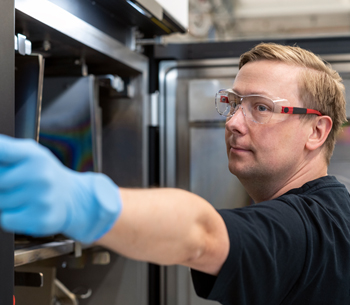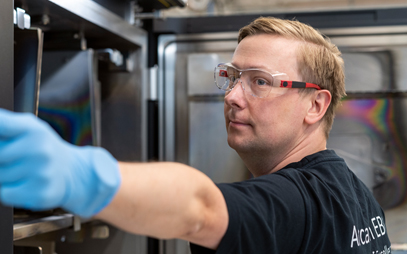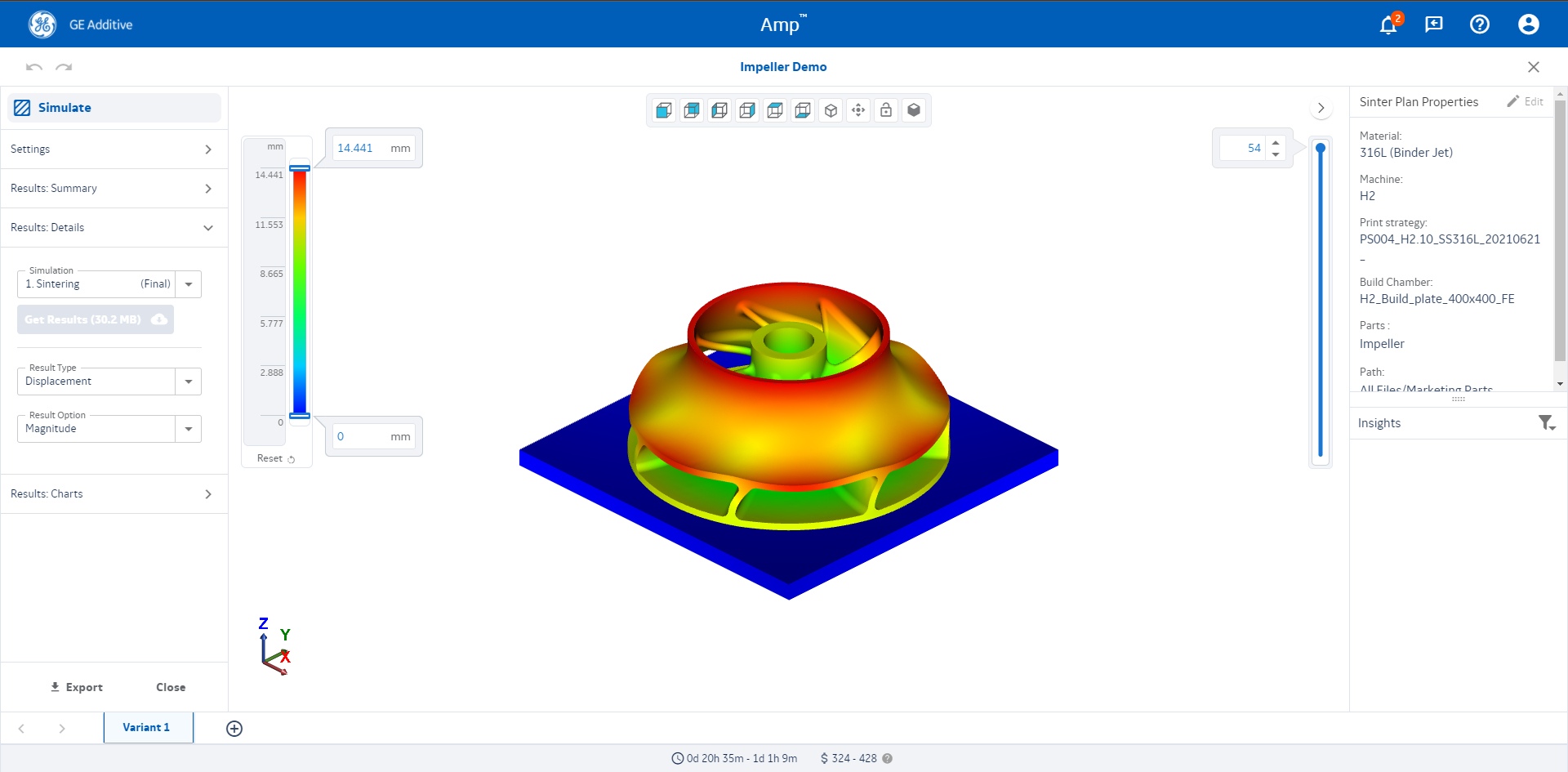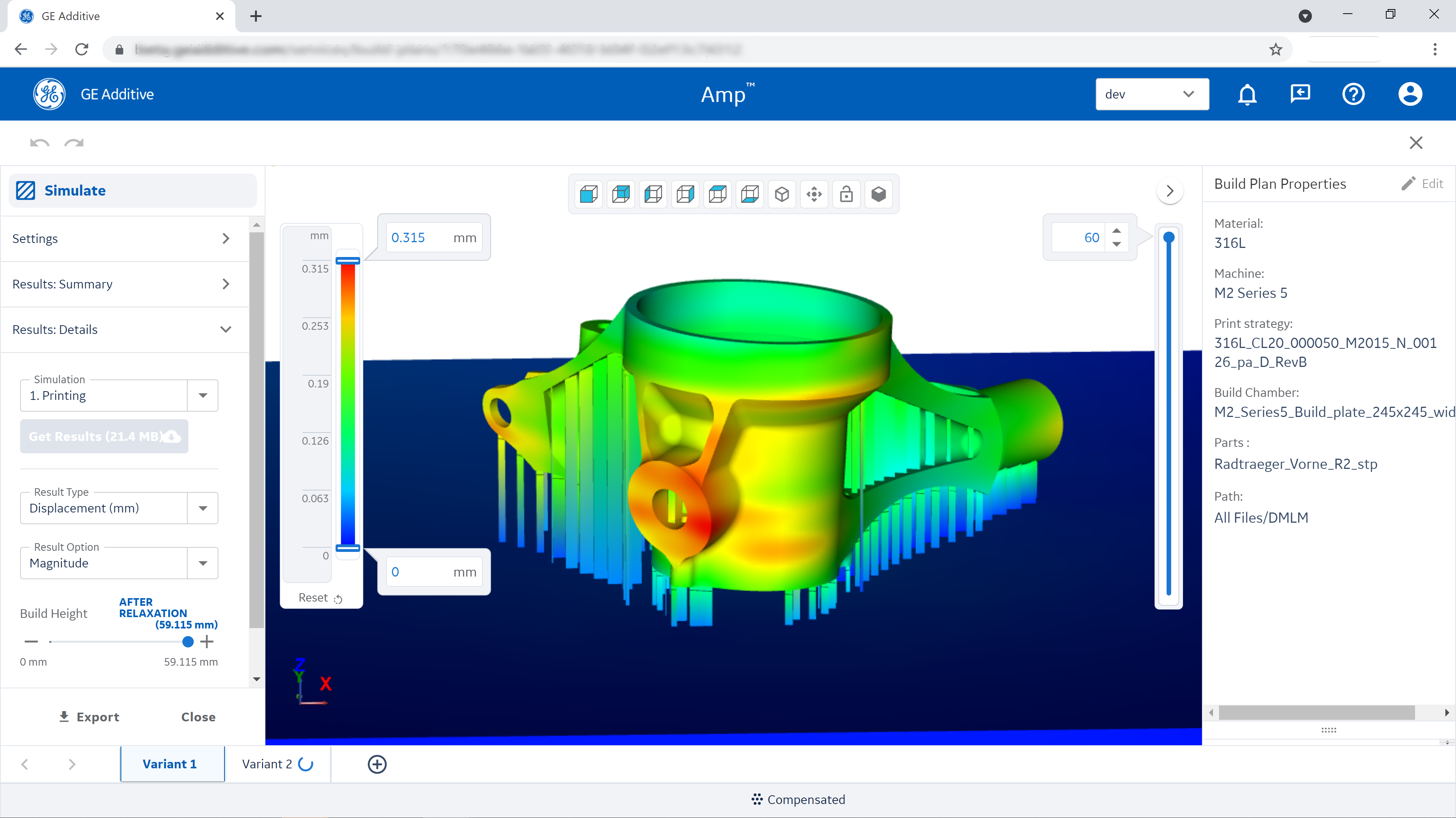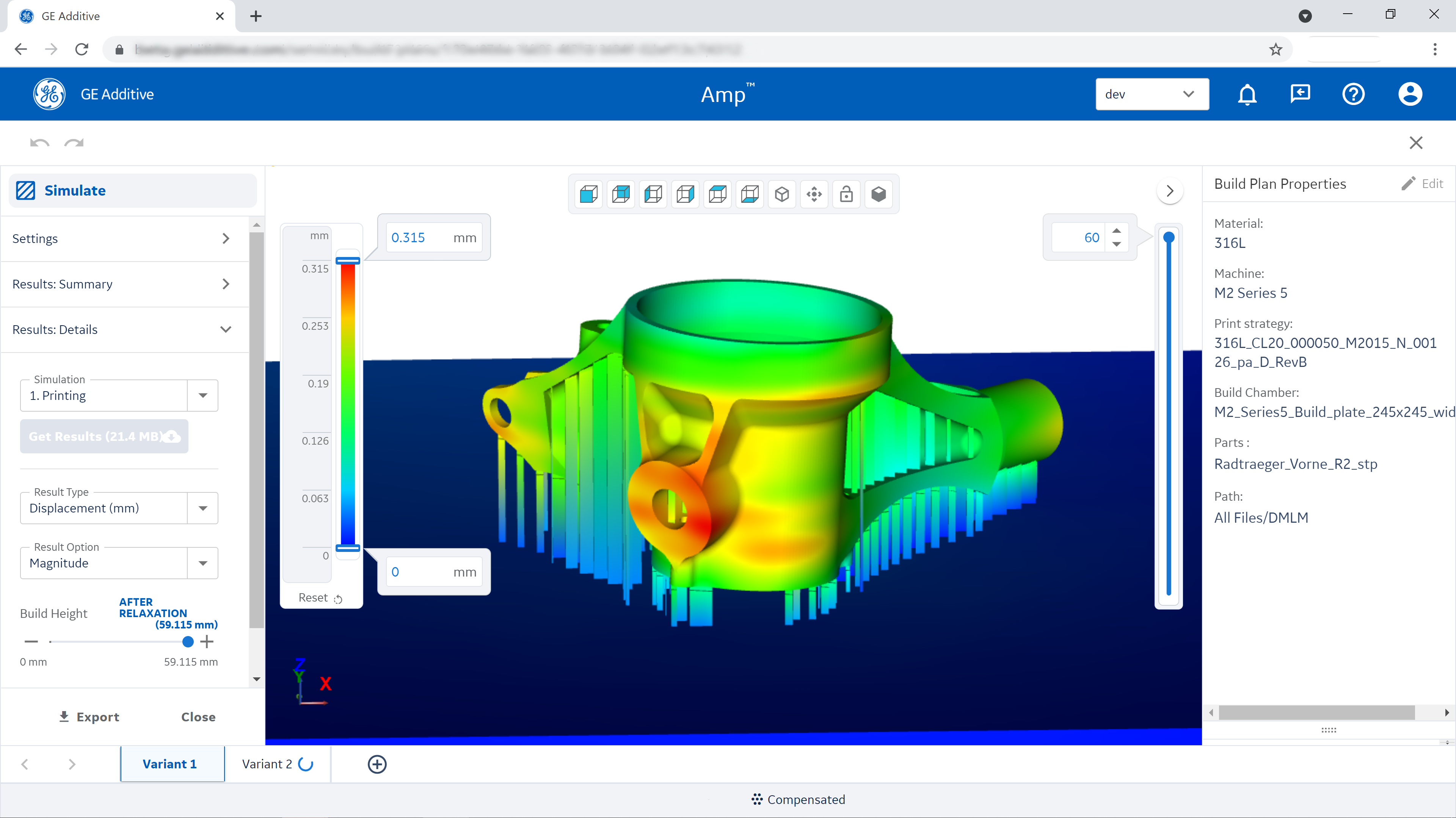By automating complex processes, such as compensation for distortion during metal 3D printing, GE Additive’s Amp software platform will let more engineers build the parts of their dreams.
In principle, the promise of metal additive manufacturing is simple: dream up a part, model it in CAD software, print it and use it. It bundles imagination, efficiency and speed into one neat engineering package.
However, today this is not yet how additive works in the real world. Metal 3D printing uses high temperatures that can cause parts to distort. The first time an engineer prints something, especially if it is complex with tight specifications, it will not always look exactly like the component envisioned by its creator.
Instead, designers need to work with experts in additive manufacturing whose extensive knowledge helps them compensate for deformations. Even then, many parts require a series of trial-and-error prints to get it right. For sophisticated components, this process may take months. Even then, some morphed shapes are so complicated, even advanced additive users might struggle to get a conforming part.
“When we started with additive, we were developing our parts through trial and error,” recalled Chris Philp, site leader for GE Aviation’s Additive Technology Center near Cincinnati, Ohio. “We would build the parts, inspect them—which can take quite a long time—to determine the quality of the part. Then we would go back and make changes to the CAD model to see if we could improve it.
“We were basically relying on our engineers’ experience about what worked and what didn’t work. We were clearly taking too long to do these trial-and-error runs, so we started looking at software to help us.”
Philp and his team found what they were looking for. GE Additive’s new additive manufacturing platform, called AmpTM, uses simulation and advanced tools to compensate for deformation and other 3D printing issues automatically. This reduces the number of trial builds needed to produce robust components.
Amp provides a single data environment for CAD data needed for build preparation, simulation & compensation. This enables project engineers to work together, using the same data within the same set of applications, as the project moves forward.
Amp embeds proven best practices and time/cost analysis. This supports the type of consistent processes and workflows needed to power real-world production environments. Amp also makes it easier—much easier—for engineers without extensive metal additive experience to 3D print parts.
Best of all, the software was developed to meet the demands and needs of GE Aviation, the world’s largest user of metal additive manufacturing. And that makes it unusual in many surprising ways.
Early Development
GE Aviation has been turning heads in metal additive manufacturing for the past decade. In 2015, its 3D-printed fuel nozzle for the LEAP jet engine set the standard for part complexity. The print consolidated 20 parts—and the steps needed to machine, assemble and braze them together—into a single structure that improved jet engine efficiency. It became the first flight-critical 3D-printed part to fly on a commercial aircraft.
GE’s new Catalyst engine, which completed its first flight in September 2021, is an original turboprop design to deliver a step change in performance and is the first turboprop in the aviation history made with 3D-printed components.
This work was done by a variety of additive specialists at GE Aviation and GE’s Global Research Center, as well as engineers at additive-related companies GE had acquired. In late 2016, GE created GE Additive to bring these resources together.
Immediately, the pressure was on to deliver results. Buoyed by GE Aviation’s successful engine work, GE Additive was finding it difficult to keep up with demand. Spurred by past successes, engineers wanted to print larger and more-complicated parts.
“Early on, it was easier to do trial-and-error compensation because the parts were small,” said Dean Robinson, additive platform leader—digital and modeling at GE Global Research in Schenectady, N.Y. “But when we started to look at replacing larger and more-complex structural castings, doing things by trial and error became impractical. You couldn’t run enough manual compensations in any reasonable amount of time.”
Under military contracts, Robinson’s team had begun using and developing software to simulate how parts evolved during printing and to compensate for their behavior automatically. These solvers were not fully developed yet, but they convinced Philp and Robinson that GE could develop useful simulation-compensation tools internally.
Johanna Sumner, a senior engineer at GE Aviation’s Additive Technology Center, was selected to bring that technology to the company. “Our mission was to cut the time spent on iterating parts, improve part quality and reduce machine downtime because of build failures that we really couldn’t foresee,” she said.
First, though, she and Philp had to convince GE Aviation’s leadership to invest in software development. Philp and Sumner made a convincing case. They put forward that there was nothing on the market that could do the type of calculations they needed, and that Robinson’s work showed that it was possible. GE Additive, meanwhile, needed those tools simply to keep up with demand.
Selling the company’s additive engineers on the tools was trickier. “We had people with a lot of experience in additive,” Sumner said. “How do we convince them that these tools we’re developing are as useful or more useful than their own design knowledge? Or that the software can provide useful guidance earlier in the design process or catch issues that they wouldn’t normally catch? It was quite a hurdle.”
There were other challenges, too. In the beginning, the tools were not accurate enough to predict how parts would distort during printing. Instead, they showed engineers how changing a build’s geometry would impact printability.
“As the software evolved, we could actually use these tools to morph the geometries,” said Tyler Nelson, a senior engineer at GE Global Research who worked on the program. “But it was still a very manual process. We were linking tools together, moving the output of one software package to another.
“Sometimes, the first compensation morph did not do a very good job. This is because complex parts often respond in nonlinear ways during compensation. If you start with a flat wall and compensation morphs it into a curved wall, it may distort very differently in the next build. So, we had to think about how we can change geometry in a more continuous way. We needed a way to keep the compensation and simulation tightly coupled.”
“The original tools were not very reliable, and they were slow,” Philp admits. Engineers on a deadline often found—especially for simpler parts—that it was faster to just run a few trial prints.
So, while Philp and Sumner now had their first software tools, they were not yet ready for prime time. GE Aviation was still relying on people, not process, to get things done.
Graphic Processors
Then, in 2017, GE Additive acquired GeonX, a Belgian startup that had found a way to solve some of the problems GE faced. Founded in 2012, GeonX did not start out as an additive software business. Instead, its goal was to develop simulation tools that could analyze and predict the distortion and residual stress caused by such conventional manufacturing techniques as welding, heat treatment and machining.
“By doing that, we gained a lot of knowledge about thermomechanical behavior that we could apply to additive manufacturing,” said Josue Barboza, who joined GeonX shortly after it started and is now a senior manager of software engineering at GE Additive.
What separated the software GeonX created, Virfac for Virtual Factory, from other simulation packages was its ability to achieve accurate results quickly.
This was due to two advances. The first was the use of the inherent-strain method to calculate distortion. Instead of performing complex thermomechanical equations, GeonX divided the problem into two parts. First, it calculated the strains created by thermomechanical expansion and contraction caused as metal powders fused together and cooled during printing for a small, representative chunk of material. Then it used data about those strains to predict mechanical changes in the full part, a much simpler set of calculations. Over time, the GeonX team also improved the accuracy of its predictions.
The second advance was to embrace graphic processing units (GPUs) to run calculations. To understand why, consider what a model of a 3D part looks like to a computer: a series of points and lines that describe the facets that make up its shape. If the shape is complex, with curves, cutouts and overhangs, it takes more points and facets to describe its shape, and the complexity of the calculation grows exponentially.
In the past, it took high-performance computers—think supercomputers—to manage the thermomechanical changes each of those sectors underwent as the part heated and cooled. High performance computing (HPC) systems are expensive to build, program and operate. They are certainly impractical for a production shop.
“Rather than trying to maintain a HPC infrastructure, we rely on graphics cards, which are relatively inexpensive,” said Adhish Majumdar, a senior software engineering manager at GE Additive explains.
Dividing the segments of the model among hundreds of inexpensive GPU cores, which were originally built to calculate the changes in segments of graphic images very quickly, produces results at surprisingly fast speeds. On small models, compensation ran two to five times faster on GeonX’s Virfac than on GE’s internal tools. As a result, engineers could complete a simulation that might otherwise take 24 hours, in a single morning.
Yet GPU arrays have a downside: small onboard memories that limit their ability to crunch lots of numbers. It is not simple to divide up a problem among hundreds of GPUs and shuttle data back and forth between them, a computer processor and system memory.
Pulling Together
Following GeonX’s acquisition by GE Additive in 2017, a group of engineers at GE Aviation began evaluating using Virfac to develop new 3D-printed jet engine parts. GE expected the GeonX team to support these projects, but conflicting priorities led to some tensions.
“GeonX was assigned a lot of tasks when GE Additive acquired them,” Sumner said. “They were trying to develop a solution to sell to a wide variety of customers, but GE Aviation’s largest parts were already pushing the limits of the software, driving the need for improvements.”
After assessing Virfac against GE’s own simulation and compensation tools, GE decided to merge its tools into the GeonX platform. GeonX would then focus on developing software to meet GE Aviation’s internal needs. In 2019, Philp, Sumner and a group of engineers traveled to Belgium for a meeting to explain what GE Aviation was doing and to create a roadmap for the future together.
“We showed them our business strategy, how complicated our models were and how they were going to get even more complicated in the future,” Philp said. “We opened our books about our software and resources and asked how we could speed up development while making sure the resulting software could really support the products we wanted to build. We wanted to establish a clear direction of where we were going.”
The meeting brought clarity. “We had discussed some of these issues before,” Majumdar said. “But those conversations were with people with different projects and objectives who all needed to solve a problem ASAP. This was different. It was a structured meeting that gave us a consolidated view of the objectives we had to achieve.”
The hard part was juggling the integration, which now involved engineers from GeonX (now part of GE Additive), GE Global Research and GE Aviation in Cincinnati as well as teams in Italy, India and Turkey. Sumner was tasked with coordinating the process.
It became a matter of teaming the right people with one another. One of them was Pinghai Yang, a senior engineer at GE Global Research and an expert in geometry and geometric algorithms. “He enabled us to build large parts whose geometries are so complex, manual compensation was completely out of the picture,” Sumner said. “His algorithms are so efficient and fast; I tell him I’m waiting for him to turn back time.”

Doing the Math
To understand how parts morph from one shape into another, Yang imagines a flexible object inside a bowl of jello. Pushing on it deforms the jello, which transfers those forces to the object within it.
If pushing on the jello with several fingers produced one-to-one change in the corresponding sites on the object, the change would be linear. As the size and complexity of the embedded object increases, then calculating these linear changes would grow in an orderly line slanted upwards.
In real life, this is not what happens. Instead, the forces from each finger interact in ways that produce sometimes surprising nonlinear changes in the object. This is exactly what happens with the strains and forces generated in 3D printing. These changes cannot be represented linearly. Instead, they require tri-cubic equations that scale exponentially. The larger and more sophisticated the part, the more the computing resources needed to simulate and compensate for the deformation curved upwards from a straight linear line.
Yang found a way to solve these nonlinear deformations linearly without reducing the accuracy of the simulation. He does this, in part, by combining a coarser calculation (with fewer points) with a calculation with a higher resolution to create the built part.
The engineers have also improved how the algorithms manage their memory so they can deliver the mathematical firepower needed to run compensations for larger and more complicated components. And no one has larger and more complicated 3D metal parts than GE Aviation.
“When we started,” Nelson said, “the simulation and compensation tools were slower, and we could apply them only to small parts and sections of larger parts. As the software got faster and better, we could look at the whole geometry. Now, we’re starting to model an entire build plate of parts. Ultra large geometries still present challenges, but we are getting there.”
As the software evolved, GE Aviation put it to work on the type of models that stymied simulation and compensation tools in the past. GeonX’s new tools were able to reduce distortion in models of large, complex parts by 50 to 70 percent and Yang’s compensation toolset closed the gap even further to create parts with minimal distortion, Sumner said. That enabled GE engineers to create a final part with only two or three test builds, often more than halving test runs and development time and costs.
Some improvements were startling. One example is a sump housing, part of GE’s Catalyst turboprop lubrication system. It is a large part with complex features that was impossible to compensate manually.
“Without compensation, the part build was so distorted they could not even measure what had happened,” Robinson said. “Using simulation-based compensation, we reduced deformation by about 60 percent, where they could easily measure, compensate and create a quality part with only a couple of test builds.”
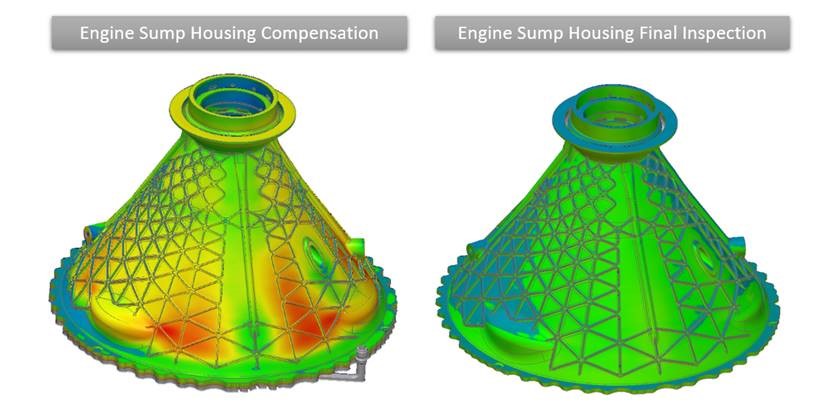
Working with larger models uncovered unexpected issues that occur only when problems scale, Robinson said. The team used this information to continue to improve the software.
By boosting speed, accuracy and simulation capacity, the team was creating a powerful set of tools for GE Aviation. It was clear the tools could support other additive users, so GE Additive decided to turn it into a commercial product.
Amping it Up
To do that, GE had to change its thinking. They had been developing tools. To commercialize the software, they envisioned a platform that would deliver on additive manufacturing’s original promise: it would make it easier for any engineer to develop and 3D print parts quickly and efficiently.
Amp would need to become an integrated platform that makes it easy for engineers to access the knowledge GE had gained about 3D design and printing over the past decade.
This started with integration. Today, engineers building a part work with a variety of software packages and plug-ins to do things like geometry creation, orientation, nesting, supports, labeling, laser scan path, model slicing and, of course, simulation and compensation. Using these disparate tools involves moving data (and sometimes converting its format) between different tools that often take experts to use.
Amp streamlines the process. It uses a single database that supports seamless data transition between one task and another. In addition to the database, Amp also incorporates the industrial knowledge, best practices and workflows, and time/cost analyses that GE Aviation and GE Additive had pioneered over the past decade.
Of course, the calculations for these tasks all depend heavily on the material and the 3D printer being used. To produce an accurate simulation, users must enter information about the build, ranging from laser power and speed to powder size and distribution.
Amp solves this problem by closely tying Amp to GE Additive’s own laser and binder jet 3D printers. This way, Amp starts with precise information about printer parameters and capabilities.
By combining this with GE’s knowledge of material properties, Amp can offer “recipes” that have been pre-populated with all the parameters they need to print their part. Robinson likens it to having a popcorn button on a microwave – where the time and power are already pre-programmed.
“It’s a wonder that it is so easy for customers to engage with,” he said. “The team has taken something that’s really complicated and simplified it. Once you’ve picked a machine, a material and the final properties you want, everything gets populated behind the scenes without the user having to type it all in. You don’t need to be a geometry expert to run that simulation. It is an experience that is accessible to everyone.”
GE Additive’s Amp will enable engineers to move through design and development faster. It will help them solve big problems, take on larger parts and make it easier to apply additive manufacturing to a broader range of parts.
It will, quite simply, help deliver on the original promises of 3D printing.
